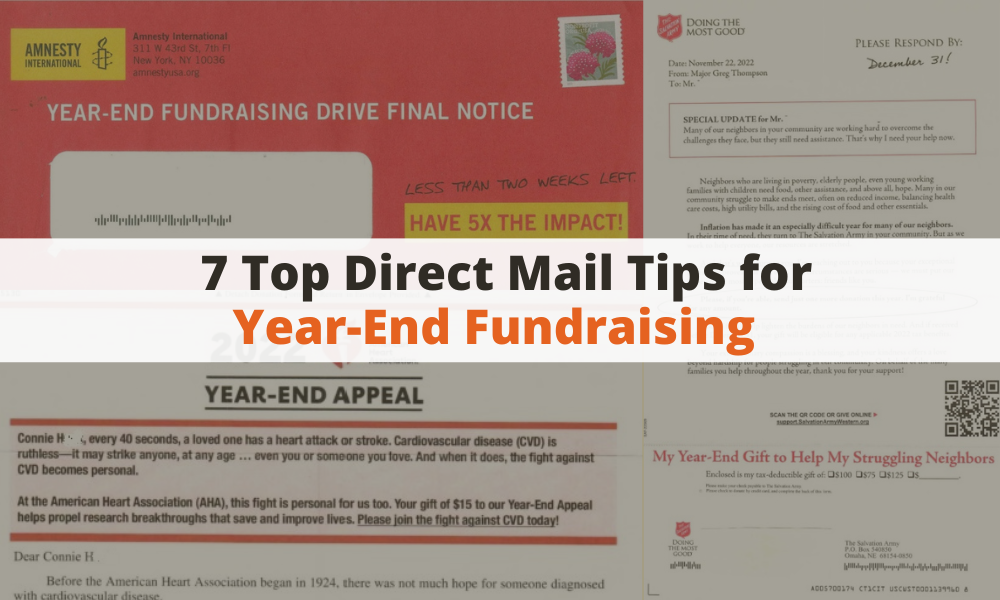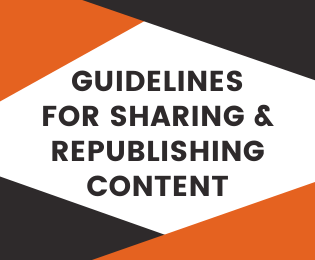INDUSTRY INSIGHTS
7 Top Direct Mail Tips for Year-End Fundraising
In this article, we’ll consider some best practices used to raise money for non-profits using direct mail, showing a few inspiring examples.
As we enter the last quarter of the year, many non-profits are – or should be – looking at their fundraising goals. Some recent studies and surveys show that giving has taken a downturn for some organizations following the bump many received during the pandemic years and the beginning of the recovery. Whether you blame inflation, an aging donor class, or something else, you want to finish the year strong. What you do over the next few months will be critical for the health of your non-profit.
This is not going to be a comprehensive how-to for year-end fundraising. Whole books and many webinars can easily be devoted to that topic. (Reach out if you’d like me to help on either of those). Instead, in this article, we’ll consider some best practices used to raise money for non-profits using direct mail. And we’ll include a few examples to inspire you, thanks to our vast collection here at Who’s Mailing What!
What Is a Year-End Fundraising Appeal?
A year-end fundraising appeal is a campaign mailed during the last few months of the year to previous donors or current members of a non-profit, asking them to make one last gift for the calendar year. It should be noted that some organizations who end their fiscal year on June 30 often reach out to donors, noting that important deadline as well.
Like nearly all fundraising mail, a letter package is the best way to reach your intended audience. But you don’t necessarily have to send direct mail out to your entire universe of potential year-end donors.
Instead, look carefully at your database and segment people using an RFM (Recency, Frequency, Monetary) analysis. Depending on your goals, you may want to prioritize last year’s donors over more recent donors or lapsed ones. If you have good data profiles (including email addresses) on those other segments, that’s an opportunity to use another channel to ask them for a year-end gift.
Why Is a Year-End Appeal So Important?
There are lots of reasons to make this special ask part of your fundraising strategy. For example:
- It’s the right thing to do
- It never hurts to ask
- It’s the holidays, and many people feel thankful and generous
- It’s a good way for a donor to get a deduction on their taxes for the current year
And oh yeah – it works.
- 31% of all giving happens in December
- 12% of all giving happens in the last three days of December alone
And I didn’t even bring up Giving Tuesday, which happens to fall during this critical period.
The point is that a year-end appeal allows your non-profit to end the year on a good note and set yourself up for next year (more on that later).
7 Top Direct Mail Tips for Year-End Fundraising
Your direct mail can stand out by reaching the right donor at the right time with the right message and motivating them to act. With powerful words and compelling images, your mail can engage them once again and help you persuade them to make a gift before the calendar turns over on December 31.
1. It’s All About The Donor, Not You
Look, I get it: you want to brag about what your organization does all year. But think about your framing. Your donor IS the hero. Put them in the driver’s seat. Just tell them how – what their gift does and how much would help – and let them save the day … once again!
Here’s an example. In the Johnson Box area of this letter from the American Heart Association, the donor’s support “helps propel research breakthroughs that save and improve lives.”
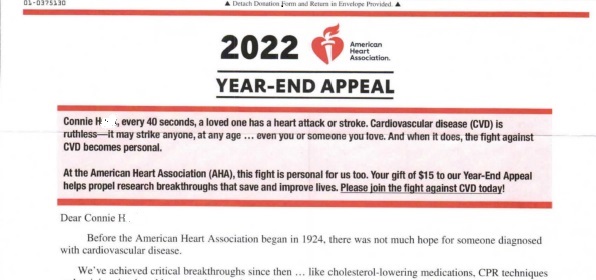
2. Tell A Story
Talking about your non-profit’s “impact” is helpful, but you want people to feel emotional about how it can be measured in meaningful changes to individual lives. Simplify your best stories by leaving out the jargon. Make them long if that does a great job pulling in the reader. Show how a problem was solved or a challenge was met on a scale donors can relate to, and leave the stats and pie charts for the annual report or a buck slip to support your message.
This appeal letter from the USA for UNHCR uses a picture and story of a Ukrainian family directly affected by the Russian attack. It also, by the way, cast the donor as a hero for their previous donations helping the organization.
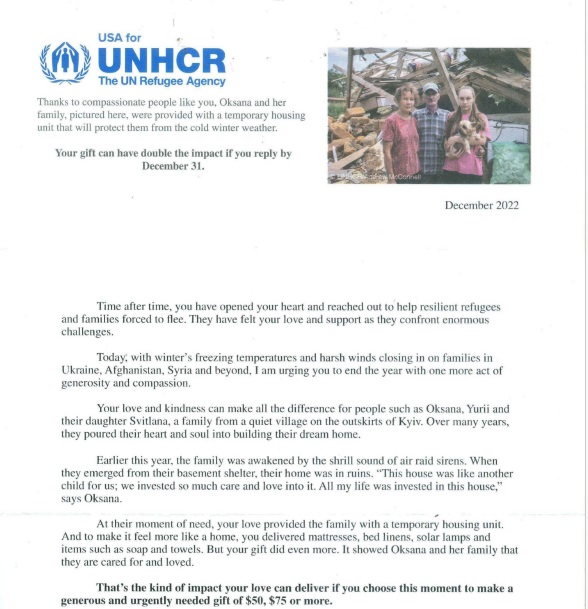
3. Use an Outstanding Outer
Sure, your contributor knows what you’re about. But let’s face it – the end of the year is a busy time, what with holidays, family visits, vacations, work, shopping … and a ton of other requests for money in their inbox and mailbox. Your envelope needs to stand out even more to get their attention, remind them of your brand, and get them inside to make that donation.
This vivid red envelope and large, reversed-out teaser copy mailed by Amnesty International certainly can’t be missed in a donor mailbox.
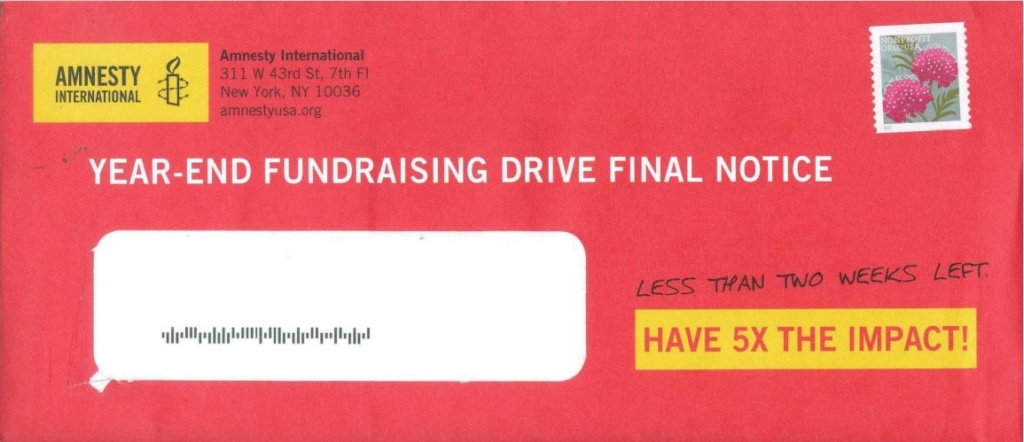
4. Leverage the Power of Others
Matching challenge campaigns are old hat because they work. But at year-end, they take on added importance as an incentive to get folks to make that last-minute gift. Be sure to make it as clear as possible what the magnified money will help to achieve, and add a note of urgency by boldfacing the deadline date for the gift in your asks.
The response form mailed by Habitat for Humanity shows the financial impact of doubling the amounts in its ask string. Also, the deadline is highlighted by a burst on the form.
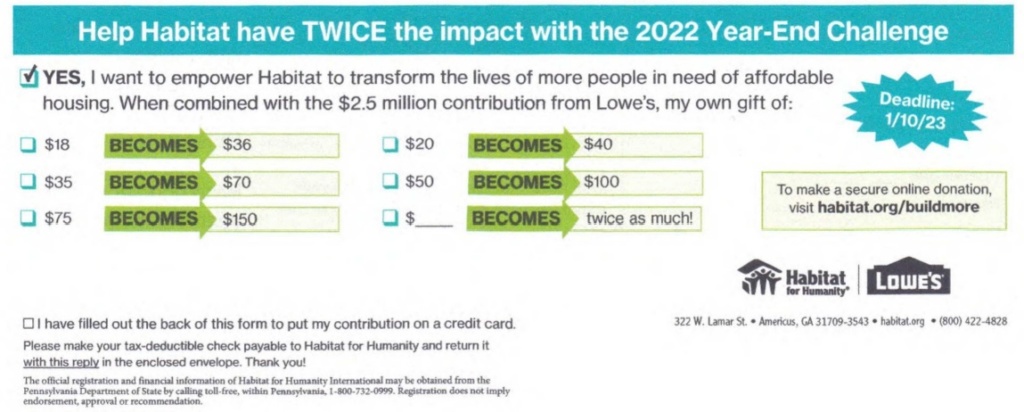
5. P.S. Don’t Forget the P.S.
A year-end appeal can be quite compelling when it runs long. Just understand that, as with any other appeal, you want to account for people who don’t read all the way through. Don’t take it personally, just put a strong ask in the P.S., as well as throughout the letter.
This year-end effort from the Tunnels to Towers Foundation sets its P.S. apart by using handwritten brackets to make its pitch.
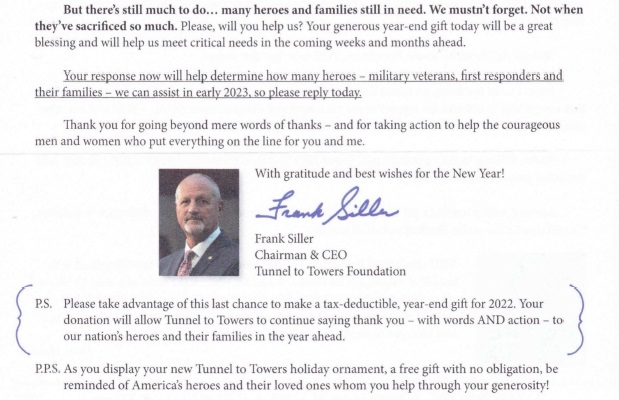
6. Give Them Options to Respond
Your direct mail’s CTA should be as clear and easy as possible for your donor. By the way, that goes for your website’s landing page too; use a big button there.
But we all know that a significant amount of non-profit donors prefer to receive and respond with mail instead of online. Make sure that you have a reply form that allows them to pay by credit card and, yes, by check. Believe it or not, a lot of people still write checks.
In this appeal from the Salvation Army, an unmissable QR code is prominently displayed on the single-page letter. Check and credit card return by mail options are also provided.
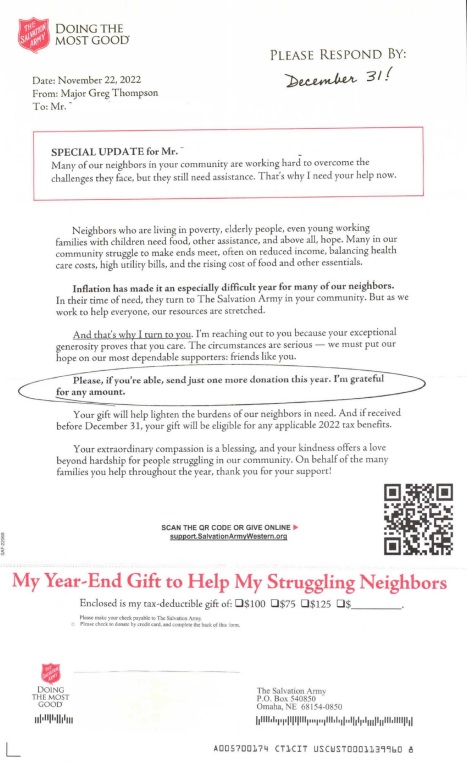
7. Thank Them. A Lot.
You know how I said that asking for money is the right thing to do? (see above).
Well, so is thanking donors for their time and generosity. Say it promptly, with genuine warmth, whether you use email, postcards, or short letters. Making them feel valued builds a spirit of stewardship.
BONUS: So I Can Relax After December 31?
Nope, not a chance. For one thing, you should reach out beyond the thank you with updates on how your organization is doing as a result of your year-end gift. Are there any new projects being started? New results you’re proud of? Talk about them! Keep your donors engaged over different channels – wherever they are, you should be as well.
For another thing, review your results by segment and/or campaigns on your channels, and start developing insights that will guide you for the months following.
Get an Edge by Learning from Fundraising Direct Mail in Who’s Mailing What!
Who’s Mailing What! includes over 829 year-end fundraising direct mail campaigns as of September 2023.
When a nonprofit mail piece is scanned for inclusion, our algorithm assigns it to one of 11 subcategories
Here’s how to filter your search and find year-end appeal mail:
- After logging in to the website, click on the Search option from the Dashboard.
- Add the term “year-end” to the search
- On the left side of the page, you’ll see Direct Mail Filters as one of the options under Filters. Scroll down to select the Nonprofit category box. All of the 11 subcategories are checked by default. Uncheck the box for any that you do not wish to include in your search.
- Click on the Apply Selected Filters box below before beginning your search.
Final Thoughts
Your non-profit’s strategy, of course, may have different goals. But the tips and ideas above are helpful reminders to focus on how you can best retain donors and keep them engaged in the year (and hopefully years) ahead.
Remember, in crafting your message, focus on the “Why” to give. Not the when. Tax benefits are nice, but this isn’t about making an exchange. It’s about renewing and hopefully strengthening a connection with your members and donors in the long term, ensuring their loyalty and friendship, and creating sustainable revenues that support your mission.







